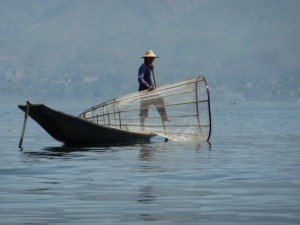-
Archives
- November 2017
- November 2016
- October 2016
- April 2016
- March 2016
- November 2015
- February 2015
- July 2014
- June 2014
- October 2013
- January 2013
- October 2012
- July 2012
- April 2012
- March 2012
- February 2012
- January 2012
- December 2011
- November 2011
- October 2011
- September 2011
- August 2011
- July 2011
- March 2011
- February 2011
- January 2011
- November 2010
- September 2010
- April 2010
- March 2010
- February 2010
- March 2009
- February 2009
- March 2008
- February 2008
- November 2006
- August 2006
- March 2006
- August 2005
- July 2005
-
Meta
Monthly Archives: March 2012
Burma: ……and Ends
Eating: One of the best parts of my travels is the eating.
The Burmese are known for their particular style of curry, which has nothing to do with Indian curry. It works like this. You go into a restaurant, which could be a 4-table modest affair on a back road between far flung villages or a popular local eatery in Rangoon, and walk to the kitchen area. There, you select a cooked protein, usually pork, chicken or beef; if you’re by a river or the sea, add options for fish and prawns to that selection. Your protein choice is already cooked in a tomato-based sauce. There are no opportunities to have it cooked fresh for you, nor are you offered various preparations of it. Regardless, that protein is only the beginning. The real glory, and the great fun, of the Burmese curry, are all the vegetables that accompany it. Each restaurant will have its own offerings, which are dished into small bowls and brought to your table along with your bowl of chicken (or whatever). Way out in the country, there might be five vegetables offered, while at that Rangoon hotspot you’d have ten or more. You spoon whichever vegetables you want onto your plate, along with heaps of rice. A tasty broth with various floating greens and sometimes spiced with black pepper comes along, too, which you spoon over everything to make it a bit more blended. And then you eat. The Burmese curry is tasty and filling. I never got tired of it.
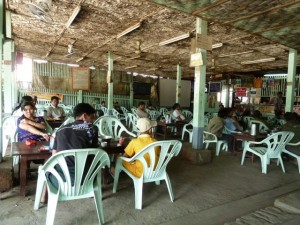
Puzzle: On our journey up the Chindwin, each guesthouse we stayed in had a room on the ground floor with the communal toilet hole (no actual commodes). To my surprise, though, there was always plenty of water piped into. However, most of the private homes that we passed on our walks had only outhouse facilities. And plenty of those houses lined the riverway, with their outhouse on the steep open river bank. These were simple long drop affairs, which begs the question: was it all leaching into the river, there to be joined by whatever flowed out of the riverboats and, maybe, even our guesthouse? And if so, was that water then being pumped up to restaurants, there to be boiled to make my dinner soup or my breakfast tea? I couldn’t dwell on this too long. I only hoped that the boiling had been lengthy. Neither Bernard nor I came down with any stomach ailment, though in part I think that’s because I made sure to eat where lots of others were eating, and to do so at the same time as they were. And I also ate and drank only what the locals did. No sense tempting fate by asking for something that might have been sitting around too long.
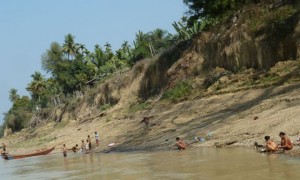
Dogs: Argentina could take a lesson from Burma on how to manage dogs. The homeless dog situation seems to be well under control and here’s how I think they do it. Noticing that nearly all the dogs on the street were male, I have deduced that only a few females are kept around and that’s purely for breeding. Any females pups in a litter are raised till they have enough meat on them and then they’re eaten. I have no proof of this, but it makes sense to me and I think it’s a clever and practical solution in a country where wasting food is not an option. As a result everyone is friendly to the dogs and they’re all in good physical condition.
Communication: Being in Burma reminded me how relaxed life used to be before cell phones, iPads, computers, et al. Burma is a cash-based economy. There are no ATMs, things are purchased as needed and transactions take place face-to-face. Phone callsl are done at the local phone stand. If you can’t reach someone, you wait, you try again later, you have a cup of sweet tea at the nearby tea shop.
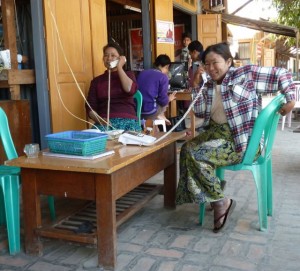
Posted in Burma, Dispatches
Leave a comment
Burma: Odds and…..
Here are some Burma odds and ends…
Getting around: Hardly anyone in Burma owns a car. One particular folly of the regime has been to construct a gorgeous 4-lane highway between Mandalay and Rangoon. It’s deserted. The rest of the roads in the country range from awful to horrible, narrow strips of broken pavement that devolve more often than not into sand tracks. 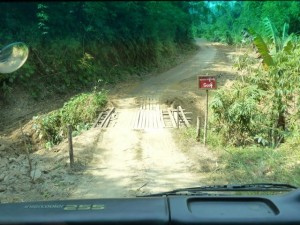 The smooth, relatively unimpeded travel on the Chindwin River (except for that day our boat ran aground on a sandbar and we were marooned in the fog for hours) was a delight compared to travel by car. The vehicle of the masses is a small motorcycle, typically from China. Bullock carts with huge wood wheels, powered by Zebu/Brahmas of impressive size, are very much in use. So are rusty, one-speed bicycles and pedicabs.
The smooth, relatively unimpeded travel on the Chindwin River (except for that day our boat ran aground on a sandbar and we were marooned in the fog for hours) was a delight compared to travel by car. The vehicle of the masses is a small motorcycle, typically from China. Bullock carts with huge wood wheels, powered by Zebu/Brahmas of impressive size, are very much in use. So are rusty, one-speed bicycles and pedicabs.
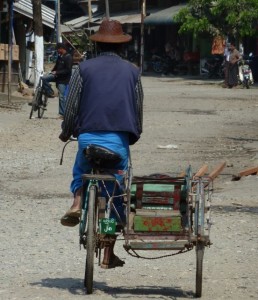
You tend to see cars only in major cities, such as Rangoon and Mandalay. It’s a dead give away who’s “in” with the regime, as they drive very shiny, new SUVs and fancy sedans. Apart from that, there are 30-year-old Toyotas, always white, generally Corollas. Since they were brought in from Japan, they have the steering wheel on the right, opposite to what you see in the U.S. But in Burma, traffic circulates as it does in the U.S., where we have the steering wheel on the left side of the car. As it happens, there are also cars in Burma with the steering wheel on the left hand, which makes for interesting viewing when you’re being driven around, as we were. If you see two people in the front seats of a car, you have no idea who’s driving until you’re right up next to them!
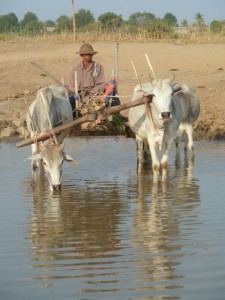
The streetscape: The streets, even in cities, are remarkably clean. And although Burma is a large country with nearly 59 million people, it does not feel congested with people the way India does. In fact, we were struck by how tidy and clean everything was, despite most structures being quite old.
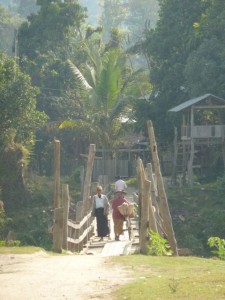
Everywhere we went we saw shopkeepers sweeping up the bits of paper and plastic that had been tossed during the day and burning them. That made for a very hazy, smoky air quality, but a nicer experience walking, that is if you can forget about the large number of red splats of spit on the sidewalk. Yes, paan, that mix of tobacco juice, a slice of areca nut and slaked lime wrapped in a betel leaf, is ubiquitous throughout Burma, chewed by men and women alike. Called kun-ya, it’s sold on every block from small glass carts and little kiosks. There’s a long tradition of chewing in Burma, but the deeply stained, red teeth and lips of the kun-ya chewers takes getting used to, as do the globules of red saliva one dodges on the street.
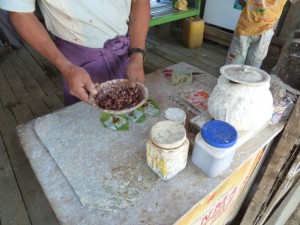
Markets: In Burma, which used to be the rice paddy of the world, before the military took over, the rice is delicious, and that’s said by someone who avoids rice whenever possible. They also have loads of vegetables: tiny yellow potatoes, sweet carrots, Roma tomatoes, cauliflower, eggplants, including a golf-ball size lavender and white one that stays crunchy when cooked.

There are always mounds of flavorful dried beans and lentils, wonderful shallot-sized red onions and garlic. And there are plenty of greens such as kale and mustard, along with interesting sour leaves from the tamarind and hibiscus, the latter called roselle and served in soups. And, of course, there are Asian things like bitter gourd and bitter green bell peppers and, yes, chilies. Meat is not a big part of the Burmese diet, but it is available in all markets, ranging from local chicken and ducks, to pork and beef. Eggs are plentiful, too. In the Chin Hills, the Chin natives raise an animal called a mithun, which is a sturdy, stocky and very cute hybrid of the wild gaur and a cow. Add the fruit that’s in season, which this time of year was watermelon, honeydew, papaya, mini-bananas and pineapples, plus several types of juicy and fragrant tangerines, and you have the makings of a bustling street market.
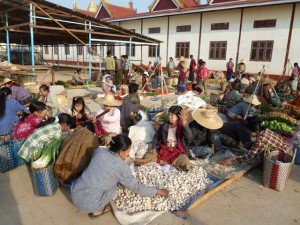
Burma’s a fascinating country and we surprised even our well-traveled selves by falling in love with the place.
Posted in Burma, Dispatches
Leave a comment
Burma’s Inle Lake
We were entranced, hypnotized by the ethereal beauty of Inle Lake. Morning to night the air was thick with smoky haze from fields being burned on the low hills that surround the shallow, thirteen-mile-long lake. Added to the lake’s own naturally thick mist, it made for difficult breathing, but bold sunsets and brazen moon rises, the queen of the day vying with the orb of night for deepest and most stirring orange. The vivid blue waters of Inle offer everything the villagers need, including the means to live right on the water itself.
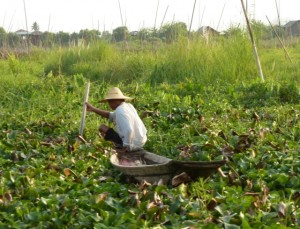
Posted in Burma, Dispatches
Leave a comment
Burma’s Backcountry
So much has happened during the past several weeks that we have been traveling through Burma. We’ve ridden an Asian elephant through teak forests up to the pilgrimage caves of Buddha’s third disciple, Alaungdaw Kathapha, dance with the tattooed Chin women in Mindat on the Chin National Day, sampled fermented sugar palm wine at a roadside stand while the palm trees across the road were tapped for their sweet sap, laid awake most of one night listening to the nonstop chanting from a nearby monastery undergoing its annual 5-day chant festival, been the only foreigners most of the villages we’ve passed through have seen in years. Our journey has been a truly remarkable experience and I feel fortunate to be here in Burma at this time of great change.
There’s a special beauty to this country, especially as seen over the span of many days as we hopped boats for 300 miles up the Chindwin River. Night comes softly in this part of western Burma. Under an apricot horizon, a lone fisherman balances on the edge of his teak skiff, flings his lace fishing net in a practiced arc, silver droplets of water spraying out from its weighted edge. A long boat trailing a dragonfly shaft sputters by, its sharp prow shattering the glassy river surface and sending brown ripples across the shallow water.
Posted in Burma, Dispatches
Leave a comment










